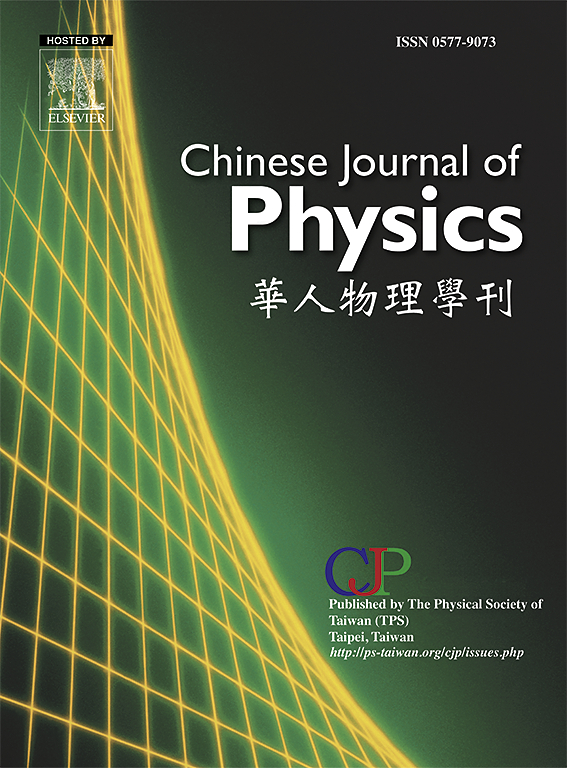On IFDM simulation of Oldroyd 8-constant fluid flowing due to motile microorganisms
IF 4.6
2区 物理与天体物理
Q1 PHYSICS, MULTIDISCIPLINARY
引用次数: 0
Abstract
This work studies the motion of bacteria on the Oldroyd 8-constant slime layer to determine the fundamental mechanism of bacterium gliding over immune system cells based on creeping flow and long wavelength approximation applicable to Stokes equations. Galilean transformation is also utilized to convert the problem from the lab to a wave frame. The bacterial gliding speed and the fluid flow rate are computed using an implicit finite difference method (IFDM), and a root-finding algorithm. These computed pairs are utilized to get power dissipation. Our results show that, due to the effect of slime rheology, characterized by relaxation time and retardation time, the gliding speed, flow rate of slime, and energy dissipation of bacteria are greatly modulated. Dynamic analysis shows that bacteria glide more quickly with reduced power dissipation when relaxation time is less than retardation time. On the other hand, relaxation time greater than the retardation time leads to slower bacterial swimming with increased energy consumption. The work presented here emphasizes that changes in the rheology of slime, specifically added time (relaxation and retardation time), can promote or inhibit bacterial motility. Additionally, the outcomes are confirmed using a separate technique based on bvp4c solver. A new comprehensive understanding of how this gliding happens (by controlling slime rheology and gliding gait) opens up possibilities for bio-inspired designs in the form of micro-robots or anti-fouling surfaces based on this work.

流动微生物引起的Oldroyd 8常数流体流动的IFDM模拟
本文基于爬行流和适用于Stokes方程的长波长近似,研究细菌在Oldroyd 8常数黏液层上的运动,以确定细菌在免疫系统细胞上滑行的基本机制。伽利略变换也被用于将问题从实验室转换为波坐标系。采用隐式有限差分法(IFDM)和寻根算法计算细菌的滑行速度和流体流速。这些计算对被用来计算功耗。结果表明,由于黏液流变特性的影响,以松弛时间和阻滞时间为特征,黏液的滑动速度、流速和细菌的能量耗散受到很大的调节。动力学分析表明,当弛豫时间小于延迟时间时,细菌滑动速度更快,功耗降低。另一方面,松弛时间大于阻滞时间,随着能量消耗的增加,细菌游动速度变慢。本文的研究强调了黏液流变学的变化,特别是增加的时间(松弛和阻滞时间),可以促进或抑制细菌的运动。此外,使用基于bvp4c求解器的单独技术验证了结果。对这种滑动是如何发生的(通过控制黏液流变和滑动步态)的新的全面理解,为基于这项工作的微型机器人或防污表面形式的生物启发设计开辟了可能性。
本文章由计算机程序翻译,如有差异,请以英文原文为准。
求助全文
约1分钟内获得全文
求助全文
来源期刊

Chinese Journal of Physics
物理-物理:综合
CiteScore
8.50
自引率
10.00%
发文量
361
审稿时长
44 days
期刊介绍:
The Chinese Journal of Physics publishes important advances in various branches in physics, including statistical and biophysical physics, condensed matter physics, atomic/molecular physics, optics, particle physics and nuclear physics.
The editors welcome manuscripts on:
-General Physics: Statistical and Quantum Mechanics, etc.-
Gravitation and Astrophysics-
Elementary Particles and Fields-
Nuclear Physics-
Atomic, Molecular, and Optical Physics-
Quantum Information and Quantum Computation-
Fluid Dynamics, Nonlinear Dynamics, Chaos, and Complex Networks-
Plasma and Beam Physics-
Condensed Matter: Structure, etc.-
Condensed Matter: Electronic Properties, etc.-
Polymer, Soft Matter, Biological, and Interdisciplinary Physics.
CJP publishes regular research papers, feature articles and review papers.
 求助内容:
求助内容: 应助结果提醒方式:
应助结果提醒方式:


